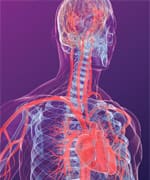Life Extension Magazine®
As the population ages, an increasing percentage of individuals face the prospect of cognitive decline and dementia.1,2
Reversing the progression of brain-wasting diseases is difficult, so prevention becomes a logical choice.
What few people realize is that there is a strong link between cardiovascular risk factors and neurological decline.3,4
Vinpocetine, a derivative of the periwinkle plant, has been used in Japan, Hungary, Germany, Poland, and Russia as a drug treatment for cerebrovascular diseases since the late 1970s.5
In this article, you’ll learn about exciting research demonstrating that vinpocetine improves cerebral blood flow, inhibits atherosclerosis, and enhances oxygen and glucose use by the brain.
Through these pathways, vinpocetine helps protect against an array of age-related neuronal insults—including memory/cognitive decline, stroke damage, vascular dementia, and Alzheimer’s disease.
The Heart-Brain Connection

In the late 1970s, several researchers became aware of a critical link between cardiovascular disease and the start of the cognitive deterioration that often turned to vascular dementia.6
This heart-brain connection remained largely ignored for many years. Scientists eventually began investigating this intriguing field where cognitive impairment could be triggered by cardiovascular issues.6
By the early 1990s, researchers were finding links between heart disease and the beginning stages of Alzheimer’s.6 Since then, continued research on this link has been driven by the Alzheimer’s disease epidemic—affecting over 5 million Americans, a number projected to increase to 16 million by 2050.7
Many large studies, including the Framingham, the Kungsholmen, and the Honolulu-Asia Aging studies, have strongly implicated hypertension (high blood pressure) in older persons as an origin of impaired cognition. It has also been well established that hypertension in the elderly is a risk factor for Alzheimer’s.6
Exactly how hypertension may lead to Alzheimer’s is not clear. However, it is suspected that the pulsatile pressure changes on the cerebral microvasculature that are generated by hypertension may damage brain endothelial cells that control cerebral blood flow.6
These vascular changes can induce chronic hypoperfusion (decreased blood flow) in the brain, leading to formation of white matter lesions. These lesions are detectable on cerebral magnetic resonance imaging (MRI) scans of Alzheimer’s patients and are considered a good marker for this fatal disease.6
Brain hypoperfusion may result from vessel stiffness secondary to atherosclerosis, increased vascular resistance, and disturbed hemodynamic (blood circulatory) flow patterns. The consequent diminished blood flow in the brain is strongly implicated in the gradual cognitive decline seen among an increasing number of aging individuals.6
Total cerebral blood flow is 20% lower in Alzheimer’s disease patients than in those without dementia.7 And studies have shown that constant low blood flow to the brain is often a marker for whether or not someone will develop Alzheimer’s.6
Effects Of Hypoperfusion On The Brain
The cascade of neuronal injuries triggered by hypoperfusion can manifest as memory loss,8,9 depression,10-13 cognitive dysfunction,14-16 and ultimately, a higher risk of stroke,17,18 vascular dementia,8,19,20 and Alzheimer’s.21-23
Why do vascular risk factors have such a powerful impact on brain health? Scientists believe it may be that this pathway adds to the reduced cerebral blood flow that is already present as a result of normal aging.6 Various risk factors for Alzheimer’s—aging, a former head injury, and the ApoE4 genotype (a gene variant with higher Alzheimer’s risk)—all have the potential to lower blood flow to the brain.6
Scientists have described a process in which chronic low blood flow to the brain results in destroying even the most resilient neurons. Chances are high that this low blood flow will ultimately manifest as Alzheimer’s.6
The urgent need for a safe way to block this destructive process is underscored by an alarming fact: The combination of hypertension and hypoperfusion is associated with smaller brain volume.24 This makes accumulating evidence on vinpocetine’s ability to inhibit this process even more critical.
What you need to know
 |
Blocking Brain Damage
- Escalating numbers of people are facing cognitive decline and dementia.
- Scientists have shown that cardiovascular risk factors and cognitive decline are intimately related.
- Extensive research demonstrates that vinpocetine, used as a cerebrovascular drug in Europe, inhibits atherosclerosis, improves cerebral blood flow, and enhances the brain’s use of glucose and oxygen.
- These activities allow vinpocetine to inhibit an array of age-related neuronal insults including memory and cognitive decline, stroke damage, vascular dementia, and Alzheimer’s disease.
Reversing Brain Decline
Once cerebral vasculature has been damaged, brain shrinkage cannot be reversed simply by reducing high blood pressure. Brain volume may continue to shrink despite successful blood pressure control.25 Once deformed and dysfunctional, the cerebral arteries in some people may need elevated blood pressure to “squeeze” blood into their brain and avoid hypoperfusion. This squeezing process causes further damage to blood vessels and increased risk of stroke.26
So while hypertension is a significant cause of arterial damage and hypoperfusion, aging humans have to do more than lower their blood pressure to reverse hypoperfusion and inhibit brain decline.
Fortunately, rodent experiments indicate that while hypoperfusion initially often reduces memory function—by inducing a state of reduced metabolism—the affected brain neurons remain structurally intact. When cerebral perfusion is restored after five weeks, the metabolically compromised neurons can return to a normal state. This finding shows that hypoperfusion can impair memory without killing neurons. More important, it suggests that hypoperfused brain cells might be rescued even after a period of reduced brain blood flow.6
This suggestion—that hypoperfused neurons may still be rescued—has been supported by clinical research on the human brain.6
Accumulating evidence now shows that vinpocetine, a derivative of vincamine from the periwinkle plant,5 provides a novel opportunity to prevent the effects of vascular risk factors on the brain. Vinpocetine thus has the potential to prevent or reverse the brain deterioration that often precedes vascular dementia and Alzheimer’s.
Vinpocetine Manages Cerebrovascular Health

Research demonstrates that vinpocetine exerts anti-atherogenic effects on blood vessels and enhances brain blood flow.27 These brain-protective effects are a result of a host of mechanisms induced by vinpocetine.
Vinpocetine directly relaxes vascular smooth muscle, making it an extremely powerful vasodilator.28 It appears to work by inhibiting the enzyme phosphodiesterase 1 (PDE1), resulting in relaxation of cerebral blood vessel walls.29 As a result, evidence shows enhanced cerebral blood flow in patients with cerebrovascular disorders.28
Vinpocetine exerts viscosity-lowering effects on blood and plasma. It also decreases platelet and red blood cell aggregation, boosts red blood cell membrane flexibility, and exhibits clinically substantiated anti-ischemic activity.28
The biological mechanisms of vinpocetine include inhibition of hypoxic damage to brain tissue, scavenging of hydroxyl radicals, anticonvulsive activity, modulation of several chemical transmitter systems, and inhibition of the reuptake of adenosine (thought to be a major endogenous anticonvulsant and cerebral protectant).28
Vinpocetine’s selective enhancement of cerebral blood flow is considered by scientists to be potentially safer than many pharmacologic vasodilators.28
Studies also show that vinpocetine enhances cerebral metabolism.28 It accomplishes this by increasing the brain’s oxygen30 and glucose uptake from the blood31-34 and by increasing neuronal production of ATP (adenosine triphosphate), a molecule that stores and transports chemical energy within cells for metabolism.35
Another useful property of this extract is its capacity to chelate metals. Vinpocetine has successfully reversed tumoral calcinosis (tumor-like calcium deposits) in hemodialysis patients with renal failure.28
Scientists have demonstrated that vinpocetine effectively increases microcirculation in the retina, as well as boosting circulation in the inner ear, which suggests potential for treating tinnitus.28
The strong anti-inflammatory activity of vinpocetine makes it a potential treatment for a range of inflammatory diseases, such as atherosclerosis, chronic obstructive pulmonary disease (COPD), arthritis, and otitis media.36
Protection Against Neurological Decline
The many brain-supportive effects of vinpocetine have been demonstrated in scientific studies to offer the potential for novel protection against a broad spectrum of neurological diseases commonly associated with brain aging.
Memory
Vinpocetine’s support in the brain for increased blood circulation and metabolism may explain its ability—proven in animal studies—to decrease the loss of neurons resulting from reduced blood flow. Based on these results, scientists conducted three controlled, clinical studies of older adults with memory problems associated with poor brain circulation or dementia-related disease. These human trials documented that vinpocetine confers significantly more improvement than a placebo in performance on comprehensive cognitive tests reflecting memory, attention, and concentration.37
Cognitive Impairment
As early as 1987, researchers showed that vinpocetine could produce a significant improvement in elderly patients with chronic cerebral dysfunction. In a double-blind clinical trial, investigators gave 42 patients 10 mg of vinpocetine daily for one month, then 5 mg for another two months, while control patients received a placebo. Supplemented patients scored better on all effectiveness scales, which included measures of cognition and overall mental status.38
Then, in 1991, 203 patients with mild-to-moderate dementia took part in a much larger, controlled, randomized trial in which they received 30 or 60 mg of vinpocetine or a placebo for 16 weeks. There were significant improvements in the supplemented group’s performance on cognitive performance scales and decreased severity of illness. Again, vinpocetine was well tolerated.39
A later review study found that vinpocetine enhanced vasodilation (or relaxation) of blood vessels and improved vascular disease-related cognitive dysfunction resulting from reduced blood flow.28
In another review of several controlled studies of older adults with memory impairment related to poor brain circulation or dementia, the study’s authors found suggestive evidence that vinpocetine produced significantly more improvement in tests of attention, concentration, and memory than a placebo.37
One study investigated blood flow in patients with ischemic stroke and mild cognitive impairment. The investigators found that vinpocetine both improved the cerebrovascular blood reserve capacity in these patients and favorably influenced their cognitive status and general condition. These results prompted the study authors to recommend vinpocetine for the treatment of patients with mild cognitive impairment.40
Based on a review of clinical studies, European scientists wrote that vinpocetine “improves the blood flow and the metabolism of the affected brain areas” and that “there is increasing evidence that vinpocetine improves the quality of life in chronic cerebrovascular patients.”41
Alzheimer’s Disease
Every 68 seconds, an American develops Alzheimer’s disease. By 2050, this rate is projected to escalate to every 33 seconds.42
Scientists treated rats with the chemical streptozocin to create a study model that mimics some Alzheimer-like cognitive problems, including impaired memory and learning. Then, by treating the rats with vinpocetine for 21 days, the research team was able to restore the rodents’ performance in a water maze and the passive avoidance test. Vinpocetine appeared to help protect against neuronal damage.43
In a later report, scientists concluded that vinpocetine’s potential to enhance neuronal plasticity and exert strong anti-inflammatory effects may have beneficial effects against Alzheimer’s and Parkinson’s, conditions in which poor neuronal plasticity and inflammation are present.44
Stroke

Vinpocetine may help prevent ischemic stroke, as well as protect against some of the damage related to stroke.
In 2003, a Bulgarian researcher summarized evidence that vinpocetine can protect brain tissue from the effects of asymptomatic cerebrovascular disease, the silent blood vessel damage that precedes a stroke. Their landmark paper cited the supplement’s ability to interfere at various stages in the cascade of events leading to stroke, including its ability to inhibit overstimulation of nerve cells, inhibit oxidation, and prevent free radical release. These scientists showed that vinpocetine passes rapidly across the blood-brain barrier and that it selectively accumulates in parts of the brain most closely related to cognitive function.
Finally, citing the known beneficial effects of vinpocetine on cerebral blood flow, the paper concluded that, “Vinpocetine may also become a new therapeutic approach to prophylactic neuroprotection in patients at high risk of ischemic stroke.” 33
This study revealed that vinpocetine was able to inhibit the release of glutamate and suppress damaging free radicals in the brain.33
Vinpocetine has been shown to inhibit atherosclerosis, the accumulation of deposits in the inner artery lining that is a major cause of stroke. In a study on mice, researchers found that vinpocetine exerts anti-atherogenic effects by inhibiting oxidative stress, inflammatory response, and adhesion of white blood cells known as monocytes.27 Another study on mice and in cultured macrophages45 examined vinpocetine’s effect on lectin-type oxidized LDL receptor 1 (LOX-1), a receptor protein that plays a role in the pathogenesis of atherosclerosis.46 The investigators discovered a novel role for vinpocetine in blocking the pathogenesis of atherosclerosis, at least partially through suppression of LOX-1 signaling.45 “Given the excellent safety profile of vinpocetine, this study suggests vinpocetine may be a therapeutic candidate for treating atherosclerosis,”45 said the study author.
While prevention of strokes is ideal, vinpocetine may also limit neurological damage following a stroke. A 2005 clinical study in Hungary documented the effects of vinpocetine on patients with multiple strokes. Patients underwent ultrasound scans of brain blood vessels to examine flow, and were then assigned either vinpocetine or a placebo supplement.
After three months, they performed a battery of cognitive tests. The brain blood flow of patients taking vinpocetine improved compared to placebo recipients. On cognitive tests, placebo patients deteriorated significantly while supplement recipients had no change at three months. This study demonstrated the neuroprotective effect of vinpocetine in patients following stroke.47
Building on this post-stroke protection, in 2012, Russian scientists conducted a multi-center, clinical-epidemiological program to investigate the effects on ischemic stroke patients when they were given vinpocetine by infusion in the acute stage of a stroke and then, given vinpocetine by tablet for a longer period. Both the supplemented and control groups received standard stroke therapy. By all indicators of efficacy measured, the supplemented group showed greater improvements. The study concluded that these two-phase interventions, using infusion followed by the administration of tablets “improve the restoration of neurological functions” in ischemic stroke patients.48
Parkinson’s Disease
An experiment was conducted to assess the neuroprotective effects of vinpocetine in an animal model of Parkinson’s disease. Rotenone, an insecticide, was used to induce Parkinsonism in a rat population and some were supplemented with different doses of vinpocetine. All rotenone-treated rats exhibited bradykinesia (slowed movement), motor impairment, depletion of dopamine in the striata (a subcortical part of the forebrain), and increased striatal levels of malondialdehyde (MDA), a marker for oxidative stress. Unlike controls, the vinpocetine-supplemented group showed a significant reversal of locomotor deficits, boosted striatal dopamine, and reduced striatal MDA. The study author concluded that vinpocetine may be considered a possible candidate in the treatment of Parkinson’s.49
Brain Damage
Researchers tested vinpocetine on newborn babies who had suffered brain damage due to trauma during birth. The supplement markedly reduced or eradicated seizures in the newborns and decreased the abnormally high pressure within their brains. This study is suggestive of vinpocetine’s broad neurological protection.50
Tinnitus and Hearing

Researchers tested vinpocetine in the treatment of acoustic trauma involving subsequent hearing loss and tinnitus. Among those who started vinpocetine supplementation within one week of the incident, 50% experienced complete disappearance of tinnitus. Vinpocetine supplementation at any time after the trauma resulted in a significant decrease in tinnitus severity in 66% of individuals and improved hearing in 79% of individuals.51
According to a 2003 study, pretreatment with vinpocetine prevented hearing loss associated with aminoglycoside antibiotics (such as gentamicin) in 118 patients under treatment for tuberculosis.52
Vinpocetine has also been found to be effective in treating Ménière’s disease (a disorder of the inner ear, affecting hearing and balance) and in treating visual impairment secondary to arteriosclerosis.53,54
Safety
Human trials and rodent studies have revealed that vinpocetine is safe, effective, and well tolerated.34,38,55 However, because vinpocetine decreases platelet aggregation, it should be used with caution in patients on blood-thinning medications.28
Summary
Increasing numbers of individuals face cognitive decline and dementia. Evidence now strongly links cardiovascular risk factors and cognitive decline. Extensive research demonstrates that vinpocetine, used in Europe since the 1970s as a cerebrovascular drug treatment, inhibits atherosclerosis, improves cerebral blood flow, and enhances oxygen and glucose use by the brain. Through these pathways, vinpocetine inhibits multiple age-related neuronal insults ranging from memory and cognitive decline to stroke damage, vascular dementia, and Alzheimer’s disease.
If you have any questions on the scientific content of this article, please call a Life Extension® Wellness Specialist at 1-866-864-3027.
References
- Available at: http://www.alz.co.uk/research/statistics. Accessed November 11, 2014.
- Corrada MM, Brookmeyer R, Paganini-Hill A, Berlau D, Kawas CH. Dementia incidence continues to increase with age in the oldest old: the 90+ study. Ann Neurol. 2010 Jan;67(1):114-21.
- Heckman GA, Patterson CJ, Demers C, St Onge J, Turpie ID, McKelvie RS. Heart failure and cognitive impairment: challenges and opportunities. Clin Interv Aging. 2007;2(2):209-18.
- Ferreira LK, Tamashiro-Duran JH, Squarzoni P, et al. The link between cardiovascular risk, Alzheimer’s disease, and mild cognitive impairment: support from recent functional neuroimaging studies. Rev Bras Psiquiatr. 2014 Jun 10.
- Available at: http://ntp.niehs.nih.gov/ntp/htdocs/chem_background/exsumpdf/vinpocetine091613_508.pdf. Accessed November 29, 2014.
- De la Torre JC. Cardiovascular risk factors promote brain hypoperfusion leading to cognitive decline and dementia. Cardiovasc Psychiatry Neurol. 2012;2012:367516.
- Roher AE, Debbins JP, Malek-Ahmadi M, et al. Cerebral blood flow in Alzheimer’s disease. Vasc Health Risk Manag. 2012;8:599-611.
- Zhao Y, Gu JH, Dai CL, et al. Chronic cerebral hypoperfusion causes decrease of O-GlcNAcylation, hyperphosphorylation of tau and behavioral deficits in mice. Front Aging Neurosci. 2014 Feb 10;6:10.
- Birdsill AC, Carlsson CM, Willette AA, et al. Low cerebral blood flow is associated with lower memory function in metabolic syndrome. Obesity (Silver Spring). 2013 Jul;21(7):1313-20.
- Alosco ML, Spitznagel MB, Cohen R, et al. Reduced cerebral perfusion predicts greater depressive symptoms and cognitive dysfunction at a 1-year follow-up in patients with heart failure. Int J Geriatr Psychiatry. 2014 Apr;29(4):428-36.
- Bonne O, Krausz Y, Gorfine M, et al. Cerebral hypoperfusion in medication resistant, depressed patients assessed by Tc99m HMPAO SPECT. J Affect Disord. 1996 Dec 16;41(3):163-71.
- Grasso MG, Pantano P, Ricci M, et al. Mesial temporal cortex hypoperfusion is associated with depression in subcortical stroke. Stroke. 1994 May;25(5):980-5.
- Onoda K, Kuroda Y, Yamamoto Y, et al. Post-stroke apathy and hypoperfusion in basal ganglia: SPECT study. Cerebrovasc Dis. 2011 31(1):6-11.
- Farkas E, de Wilde MC, Kiliaan AJ, Luiten PG. Chronic cerebral hypoperfusion-related neuropathologic changes and compromised cognitive status: window of treatment. Drugs Today (Barc). 2002 May;38(5):365-76.
- Vicente E, Degerone D, Bohn L, et al. Astroglial and cognitive effects of chronic cerebral hypoperfusion in the rat. Brain Res. 2009 Jan 28;1251:204-12.
- Bennett SA, Tenniswood M, Chen JH, et al. Chronic cerebral hypoperfusion elicits neuronal apoptosis and behavioral impairment. Neuroreport. 1998 Jan 5;9(1):161-6.
- Hillis AE, Wityk RJ, Barker PB, et al. Subcortical aphasia and neglect in acute stroke: the role of cortical hypoperfusion. Brain. 2002 May;125(Pt 5):1094-104.
- Pullicino PM, McClure LA, Wadley VG, et al. Blood pressure and stroke in heart failure in the REasons for Geographic And Racial Differences in Stroke (REGARDS) study. Stroke. 2009 Dec;40(12):3706-10.
- Román GC. Brain hypoperfusion: a critical factor in vascular dementia. Neurol Res. 2004 Jul;26(5):454-8.
- Schuff N, Matsumoto S, Kmiecik J, et al. Cerebral blood flow in ischemic vascular dementia and Alzheimer’s disease, measured by arterial spin-labeling magnetic resonance imaging. Alzheimers Dement. 2009 Nov;5(6):454-62.
- De la Torre JC. Critical threshold cerebral hypoperfusion causes Alzheimer’s disease? Acta Neuropathol. 1999 Jul;98(1):1-8.
- Kim HA, Miller AA, Drummond GR, et al. Vascular cognitive impairment and Alzheimer’s disease: role of cerebral hypoperfusion and oxidative stress. Naunyn Schmiedebergs Arch Pharmacol. 2012 Oct;385(10):953-9.
- Nishimura T, Hashikawa K, Fukuyama H, et al. Decreased cerebral blood flow and prognosis of Alzheimer’s disease: a multicenter HMPAO-SPECT study. Ann Nucl Med. 2007 Jan;21(1):15-23.
- Alosco ML, Brickman AM, Spitznagel MB, et al. Independent and interactive effects of blood pressure and cardiac function on brain volume and white matter hyperintensities in heart failure. J Am Soc Hypertens. 2013 Sep-Oct;7(5):336-43.
- Jennings JR, Mendelson DN, Muldoon MF, et al. Regional grey matter shrinks in hypertensive individuals despite successful lowering of blood pressure. J Hum Hypertens. 2012 May;26(5):295-305.
- Iadecola C, Davisson RL. Hypertension and cerebrovascular dysfunction. Cell Metab. 2008 Jun;7(6):476-84.
- Zhuang J, Peng W, Li H, et al. Inhibitory effects of vinpocetine on the progression of atherosclerosis are mediated by Akt/NF-κB dependent mechanisms in apoE-/- mice. PLoS One. 2013 Dec 9;8(12):e82509.
- Kidd PM. A review of nutrients and botanicals in the integrative management of cognitive dysfunction. Altern Med Rev. 1999 Jun;4(3):144-61.
- Wang K, Wen L, Peng W, et al. Vinpocetine attenuates neointimal hyperplasia in diabetic rat carotid arteries after balloon injury. PLoS One. 2014 May 12;9(5):e96894.
- Bönöczk P, Panczel G, Nagy Z. Vinpocetine increases cerebral blood flow and oxygenation in stroke patients: a near infrared spectroscopy and transcranial Doppler study. Eur J Ultrasound. 2002 Jun;15(1-2):85-91.
- Szakáll S, Boros I, Balkay L, et al. Cerebral effects of a single dose of intravenous vinpocetine in chronic stroke patients: a PET study. J Neuroimaging. 1998 Oct;8(4):197-204.
- Vámosi B, Molnár L, Demeter J, Túry F. Comparative study of the effect of ethyl apovincaminate and xantinol nicotinate in cerebrovascular diseases. Immediate drug effects on the concentrations of carbohydrate metabolites and electrolytes in blood and CSF. Arzneimittelforschung. 1976;26(10a):1980-4.
- Hadjiev D. Asymptomatic ischemic cerebrovascular disorders and neuroprotection with vinpocetine. Ideggyogy Sz. 2003 May 20;56(5-6):166-72.
- Vas A, Gulyas B, Szabo Z, et al. Clinical and non-clinical investigations using positron emission tomography, near infrared spectroscopy and transcranial Doppler methods on the neuroprotective drug vinpocetine: a summary of evidences. J Neurol Sci. 2002 Nov 15;203-204:259-62.
- Jeon KI, Xu X, Aizawa T, et al. Vinpocetine inhibits NF-kB–dependent inflammation via an IKK-dependent but PDE-independent mechanism. Proc Natl Acad Sci USA. 2010 May 25;107(21):9795-800.
- Available at: http://www.urmc.rochester.edu/news/story/index.cfm?id=2836. Accessed November 11, 2014.
- McDaniel MA, Maier SF, Einstein GO. “Brain-specific” nutrients: a memory cure? Nutrition. 2003 Nov;19(11-12):957-75.
- Balestreri R, Fontana L, Astengo F. A double-blind placebo controlled evaluation of the safety and efficacy of vinpocetine in the treatment of patients with chronic vascular senile cerebral dysfunction. J Am Geriatr Soc. 1987 May;35(5):425-30.
- Hindmarch I, Fuchs HH, Erzigkeit H. Efficacy and tolerance of vinpocetine in ambulant patients suffering from mild to moderate organic psychosyndromes. Int Clin Psychopharmacol. 1991;6(1):31-43.
- Valikovics A. Investigation of the effect of vinpocetine on cerebral blood flow and cognitive functions. Ideggyogy Sz. 2007 Jul 30;60(7-8):301-10.
- Bagoly E, Feher G, Szapary L. The role of vinpocetine in the treatment of cerebrovascular diseases based in human studies. Orv Hetil. 2007 Jul 22;148(29):1353-8.
- Alzheimer’s Association. 2012 Alzheimer’s disease facts and figures. Alzheimers Dement. 2012;8(2):131-68.
- Deshmukh R, Sharma V, Mehan S, Sharma N, Bedi KL. Amelioration of intracerebroventricular streptozotocin induced cognitive dysfunction and oxidative stress by vinpocetine – a PDE1 inhibitor. Eur J Pharmacol. 2009 Oct 12;620(1-3):49-56.
- Medina AE. Therapeutic utility of phosphodiesterase type I inhibitors in neurological conditions. Front Neurosci. 2011 Feb 18;5:21.
- Cai Y, Li JD, Yan C. Vinpocetine attenuates lipid accumulation and atherosclerosis formation. Biochem Biophys Res Commun. 2013 May 10;434(3):439-43.
- Mehta JL, Chen J, Hermonat PL, Romeo F, Novelli G. Lectin-like, oxidized low-density lipoprotein receptor-1 (LOX-1): a critical player in the development of atherosclerosis and related disorders. Cardiovasc Res. 2006;69:36-45.
- Kemeny V, Molnar S, Andrejkovics M, Makai A, Csiba L. Acute and chronic effects of vinpocetine on cerebral hemodynamics and neuropsychological performance in multi-infarct patients. J Clin Pharmacol. 2005 Sep;45(9):1048-54.
- Tabeeva GR, Azimova IuE. The multimodal strategy for the neuroprotection in stroke: results of the Russian multicenter clinical-epidemiological program SOKOL. Zh Nevrol Psikhiatr Im S S Korsakova. 2012;112(12 Pt 2):20-30.
- Zaitone SA, Abo-Elmatty DM, Elshazly SM. Piracetam and vinpocetine ameliorate rotenone-induced Parkinsonism in rats. Indian J Pharmacol. 2012 Nov-Dec;44(6):774-9.
- Dutov AA, Gal’tvanitsa GA, Volkova VA, et al. Cavinton in the prevention of the convulsive syndrome in children after birth injury. Zh Nevropatol Psikhiatr m SS orsakova. 1991;91(8):21-2.
- Konopka W, Zalweski P, Olszewski J, et al. Treatment of acoustic trauma. Otolaryngol Pol. 1997;51:281S-4S.
- Maliavina US, Ovchinnikov I, Fasenko VP, et al. Cavinton prevention of neurosensory hypoacousis in patients with different forms of tuberculosis. Vestn Otorinolaringol. 2003;(3):35-40.
- Ribari O, Zelen B, Kollar B. Ethyl apovincaminate in the treatment of sensorineural impairment of hearing. Arzneimittelforschung 1976;26:1977-80.
- Kahan A, Olah M. Use of ethyl apovincaminate in ophthalmological therapy. Arzneimittelforschung 1976;26:1969-1972.
- Feigin VL, Doronin BM, Popova TF, Gribatcheva EV, Tchervov DV. Vinpocetine treatment in acute ischaemic stroke: a pilot single-blind randomized clinical trial. Eur J Neurol. 2001 Jan;8(1):81-5.

